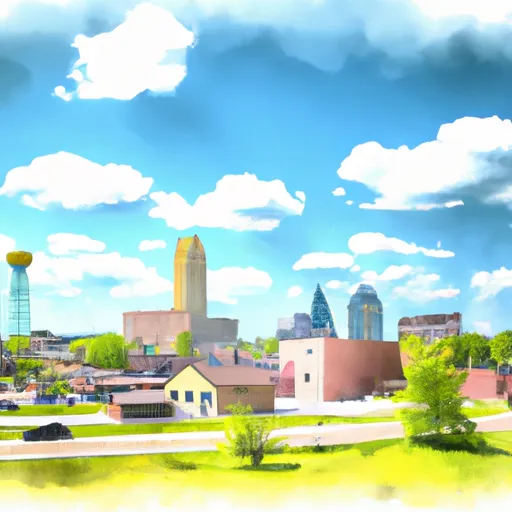-
 Snoflo Premium
Snoflo Premium
Get unlimited access to all our content
With no Ad interruptions! - Start Your Free Trial Login with existing account
Germfask
Eden Index
Climate
6.1
•
Recreation
3.5
•
Community
•
Safeguard
3.7/10

Germfask, Michigan is a small town located in the Upper Peninsula of Michigan. The climate is characterized by cold winters and mild summers, with an average annual temperature of 43°F. The area is fed by several small creeks and rivers, including the Manistique River, which offers excellent fishing opportunities. The hydrology constituents of the area are predominantly composed of sand and gravel deposits, resulting in well-drained soils. This creates ideal conditions for outdoor recreation, with activities such as camping, hiking, hunting, and fishing being popular among visitors. With its beautiful scenery, Germfask is the perfect destination for nature lovers who enjoy exploring the great outdoors.
What is the Eden Index?
The Snoflo Eden Index serves as a comprehensive rating system for regions, evaluating their desirability through a holistic assessment of climate health, outdoor recreation opportunities, and natural disaster risk, acknowledging the profound impact of these factors on livability and well-being.
Climate Health Indicator (CHI): 6.1
Germfask receives approximately
793mm of rain per year,
with humidity levels near 83%
and air temperatures averaging around
6°C.
Germfask has a plant hardyness factor of
5, meaning
plants and agriculture in this region thrive during a short period during spring and early summer. Most
plants will die off during the colder winter months.
By considering the ideal temperature range, reliable water supplies, clean air, and stable seasonal rain or snowpacks, the Climate Health Indicator (CHI) underscores the significance of a healthy climate as the foundation for quality living.
A healthy climate is paramount for ensuring a high quality of life and livability in a region, fostering both physical well-being and environmental harmony. This can be characterized by ideal temperatures, reliable access to water supplies, clean air, and consistent seasonal rain or snowpacks.
Weather Forecast
Streamflow Conditions
Northeastern Lake Michigan
Area Rivers
Northeastern Lake Michigan
Snowpack Depths
Northeastern Lake Michigan
Reservoir Storage Capacity
Northeastern Lake Michigan
Groundwater Levels
Recreational Opportunity Index (ROI): 3.5
The Recreational Opportunity Index (ROI) recognizes the value of outdoor recreational options, such as parks, hiking trails, camping sites, and fishing spots, while acknowledging that climate plays a pivotal role in ensuring the comfort and consistency of these experiences.
Access to outdoor recreational opportunities, encompassing activities such as parks, hiking, camping, and fishing, is crucial for overall well-being, and the climate plays a pivotal role in enabling and enhancing these experiences, ensuring that individuals can engage in nature-based activities comfortably and consistently.
Camping Areas
| Campground | Campsites | Reservations | Toilets | Showers | Elevation |
|---|---|---|---|---|---|
| Pines Point | 94 | 717 ft | |||
| Blind Sucker 1 - State Forest | 13 | 634 ft | |||
| Diamond Lake Co Park | 60 | 953 ft | |||
| Fremont Lake City Park | None | 747 ft | |||
| Utley Lake | 9 | 808 ft | |||
| Minnie Pond | 18 | 850 ft | |||
| Blind Sucker 2 - State Forest | 32 | 635 ft | |||
| Woodland Park | 132 | 628 ft | |||
| Ed H. Henning Park | 60 | 700 ft | |||
| Lake Superior - State Forest | 18 | 627 ft |
Nearby Ski Areas
Catastrophe Safeguard Index (CSI):
The Catastrophe Safeguard Index (CSI) recognizes that natural disaster risk, encompassing floods, fires, hurricanes, and tornadoes, can drastically affect safety and the overall appeal of an area.
The level of natural disaster risk in a region significantly affects safety and the overall livability, with climate change amplifying these risks by potentially increasing the frequency and intensity of events like floods, fires, hurricanes, and tornadoes, thereby posing substantial challenges to community resilience and well-being.
Community Resilience Indicator (CRI):
The Community Resilience Indicator (CRI) recognizes that education, healthcare, and socioeconomics are crucial to the well-being of a region. The CRI acknowledges the profound impact of these elements on residents' overall quality of life. By evaluating educational resources, healthcare accessibility, and economic inclusivity, the index captures the essential aspects that contribute to a thriving community, fostering resident satisfaction, equity, and social cohesion.

